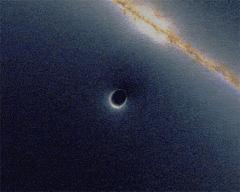By Victor Allegretti
Douglas Adams once wrote, “There is a theory which states that if ever for any reason anyone discovers what exactly the Universe is for and why it is here it will instantly disappear and be replaced by something even more bizarre and inexplicable. There is another that states that this has already happened.”
A common problem with astrophysics is gravity’s insistence on non-conformity with the three other basic forces of nature: the strong and weak nuclear forces and electromagnetism. Dark energy also mischievously causes physicists to scratch their heads; it expands our universe at an accelerating rate, even though gravity should be contracting it or at least slowing the expansion.

While there isn’t any formal research to Douglas Adams’ statement, there is research from Nikodem Poplawski of Indiana University that postulates our universe exists inside of a black hole somewhere in space. He believes that the classic dark energy and gravity enigmas are the result of physicists commonly stopping their research for the origins of our universe at the Big Bang. According to Poplawski’s research, the collapse of a massive star in another universe could have created a wormhole, a space-time “bridge” (hence the name Einstein-Rosen bridges) to another point in space-time. Poplawski theorizes that within this wormhole, conditions could have existed similar to those associated with the Big Bang, thus possibly forming our universe.
The current conundrums of dark energy and non-conforming gravity can be addressed by this theory. If a universe existed prior to our own, it is possible that nuclear forces and electromagnetism played nice with gravity, and if our universe is expanding towards the end of the wormhole, the inexplicable expansion of our universe can be explained sans dark energy. Don’t be too excited to see whatever strange and bizarre cosmos exists beyond our own, however. The physics of wormholes are similar to the physics of black holes. If you could ever pass through the event horizon of the wormhole to visit the universe on the other side, you could never return. “You will be stuck,” Poplawksi says.
Hopefully Douglas Adams wasn’t right.
Sources:
